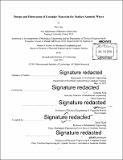Design and fabrication of granular materials for surface acoustic waves
Author(s)
Gan, Tian, S.M. Massachusetts Institute of Technology
DownloadFull printable version (19.17Mb)
Other Contributors
Massachusetts Institute of Technology. Department of Electrical Engineering and Computer Science
Advisor
Nicholas Fang.
Terms of use
Metadata
Show full item recordAbstract
Granular materials with structural discreteness and periodicity can lead to novel propagation behaviors of mechanical waves. Acoustic studies of granular media typically involve macroscopic particles whereas contact-based vibrations of microparticles remain largely unexplored. The adhesion which can be neglected on millimeter scale is significant on micron scales and therefore microparticles are expected to yield qualitatively different dynamics. We model the microparticle array as locally resonant metamaterials for surface acoustic waves by using the effective medium approach. In experiment, we employ the convective assembly method to fabricate the centimeter-sized, two-dimensional granular crystal consisting of 1[mu]m silica spheres adhered to the substrate. Laser-induced transient grating technique is used to generate and detect surface acoustic waves in microsphere array samples. We demonstrate, both experimentally and by theoretical analysis, that the Rayleigh wave in the substrate interacts with the contact resonance of microspheres leading to hybridization and "avoided-crossing" at a high frequency regions~10 2 MHz. Furthermore, we fabricate the microsphere waveguide structure by template-assisted-self-assembly. By using the same laser technique, we have observed the waveguide behavior in experimental measurement.
Description
Thesis: S.M., Massachusetts Institute of Technology, Department of Mechanical Engineering, 2015. Thesis: S.M., Massachusetts Institute of Technology, Department of Electrical Engineering and Computer Science, 2015. Cataloged from PDF version of thesis. Includes bibliographical references (pages 134-147).
Date issued
2015Department
Massachusetts Institute of Technology. Department of Electrical Engineering and Computer Science; Massachusetts Institute of Technology. Department of Mechanical EngineeringPublisher
Massachusetts Institute of Technology
Keywords
Mechanical Engineering., Electrical Engineering and Computer Science